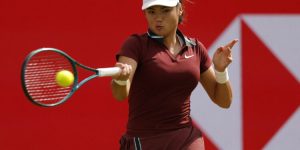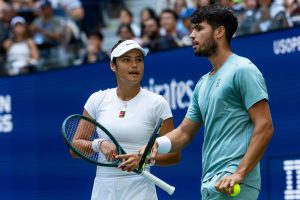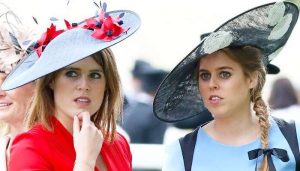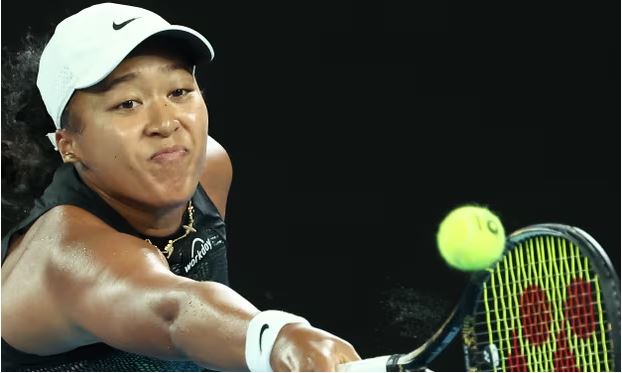
Japan’s Naomi Osaka serves against Danielle Collins of the US during the women’s singles match at the Mubadala Abu Dhabi Open tennis tournament in Abu Dhabi on February 6, 2024. (Photo by RYAN LIM / AFP)
Naomi Osaka may have been unable to mark her comeback with the instant glory she craved, but on her return to grand slam tennis on Monday the four-time major champion showed she is on the right path. The former world No 1 tussled with one of the best players in the world before narrowly losing 6-4, 7-6(2) against Caroline Garcia in the first round of the Australian Open.
After contesting her first tournament since September 2022 at the beginning of the year in Brisbane, the Australian Open is Osaka’s second competition since she gave birth to her daughter, Shai, in July.
Across the two sets Osaka and Garcia, the 20th seed, pushed each other to produce high-quality first-strike tennis. Both competitors served spectacularly, unloading off both wings and refusing to relinquish ground from inside the baseline. The difference was simply the match tightness and consistency of Garcia, who navigated two competitive, high-quality sets without dropping her serve and she soared in the decisive tiebreak.
“I thought it was a really good match,” Osaka said. “For me, I felt like I did the best that I could possibly do. It was just really nice to be on Rod Laver [Arena] again, hear the audience, how much they interacted with the match. That was fun.”
A 16-month layoff has done little to blunt Osaka’s heavy weaponry. Her first serve remains one of the most destructive shots in the game and her pace and weight of shot has few equals. Throughout the night, her thunderous forehand drew gasps from the crowd.
“For someone who has been out for 15 months, giving birth six months ago, it’s quite impressive,” Garcia said. “I think if she comes back and plays [a] tournament, that means she feels ready and she’s motivated to go get some big titles again. Her ball is heavy, serve is heavy, forehand is heavy. Come fast. You have to be really ready.”
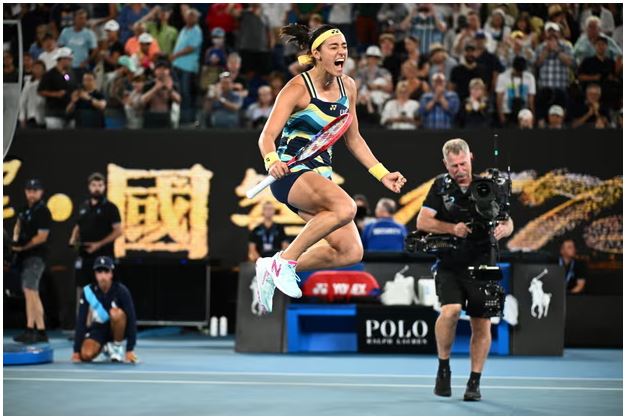
In this early stage of Osaka’s comeback, though, she is still regaining her sharpness on her return of serve, her shot tolerance in extended rallies and her movement. With more matches and time on the court, the rest of her game will surely come together.
“I have to tell myself: ‘Hey, six months ago you were pregnant,’ stuff like that,” Osaka said. “Of course, there’s a voice in my head that is: ‘Who are you to think you can come back and immediately start winning matches?’ I don’t know. I kind of always expect myself to stand a chance anyway. So I guess just being nicer to myself is like a key thing that I learned in my time away.”
In recent years, Naomi Osaka has gained a reputation for playing too infrequently, even when she continued to peak at the big events and win grand slam titles. While her game will likely return, the biggest question surrounding her comeback is whether she will be willing to throw herself into playing a full schedule and to endure the difficult learning curve that could be required of her on the path to rediscovering her top form. According to Osaka, she will indeed plan a far busier schedule this year and next month she will head to Dubai in search of more matchplay.
“The competitor in me is really frustrated that I’m not winning these matches, of course,” Osaka said. “So I wouldn’t say this comeback is how I thought because I’m delusional enough to think I could have won the tournament. I think my delusion is what allows me to win the tournaments. I think I just have to keep living day by day and training hard and playing a lot more matches, and hopefully my dreams will come true.”
